Not long ago, Amber Brown, a student at Everest University, saw an article on Facebook about one of the many lawsuits against her school. The story, she wrote to BuzzFeed News, "dumbfounded" her: It mentioned former students facing mountains of debt for their degrees, but that didn't seem to apply to her. Brown believed that she was "on a 100% Pell Grant through the government" and didn't owe a cent.
Everest even paid for her books and her laptop, she wrote, and sent her a stipend check every semester. "Will I have to pay this back or am I one of the few students being treated genuinely by Everest University?" she asked.
In reality, most of what Brown believed to be a Pell Grant was actually loans: A review of documents she provided showed she owes more than $26,000.
Brown, 29, who lives in Kentucky and enrolled at Everest in 2011, has yet to learn that she is going into debt for her degree. (Her last name has been changed because she is a current student.) She no longer has a phone because she is unable to pay the bills, and she sent her student loan documents from a computer at a nearby food bank where she accesses the internet. She has since been hospitalized, unreachable by phone or email.
Like thousands of other students, Brown has fallen victim to a predatory lender that exploits the aspirations of the poor and disadvantaged. She had good reason to trust Everest Colleges and Universities and its representatives: It is a nationally accredited college, plugged into the government-backed student loan system that pays for the education of millions of students each year. But for thousands of desperate and financially unsophisticated students at Everest, that trust was deeply misplaced.
Corinthian Colleges, Everest's publicly traded parent company, is facing a slew of lawsuits and investigations alleging it falsified job records and misrepresented itself to students. The company is effectively being shut down by the federal government; by early next year, it will no longer own any colleges.
Since July, I have heard from more than 150 current and former students who reached out to me through email, phone, text message, and Facebook after a story about Everest I wrote in April began circulating widely among former students. The vast majority I spoke to were poor women, many of them minorities, who said they were lured to enroll with promises of jobs and good wages that would support their families. They told me they had taken out tens of thousands of dollars in loans, often without understanding the extent of their debt, and sometimes not even knowing they were in debt at all. The tactics that admissions officers had used to convince them to enroll, they said, were manipulative and unethical; lawsuits allege they were illegal.
By the end of their programs, students owed as much as $50,000, and few believe they will ever be able to repay even a fraction of it. Most said they graduated without jobs, then returned to unemployment or low-paying work in fast-food or retail. They used words like "betrayed," "lied to," and "victimized." Many begged for help.
Corinthian, Everest’s parent company, has routinely denied most of the allegations in the many lawsuits against the company. Its spokesperson, Kent Jenkins, said that Corinthian has found employment for the "vast majority" of its tens of thousands of graduates, and that the school regularly provided students with "clear and accurate" information about the cost of their educations and the ability of credits to transfer. He denied that admissions representatives used aggressive or unethical tactics to coerce students into enrolling. Corinthian's accreditation and job placement standards, he said, are far more stringent than those at community colleges offering similar programs.
Corinthian is being sued by the Consumer Financial Protection Bureau and attorneys general in California, Massachusetts, and Wisconsin, and faces investigations by the Securities and Exchange Commission and six more states, as well as a criminal probe in California. Earlier this year, the Department of Education reached an unprecedented agreement to essentially shut down Corinthian, which was teetering on the edge of bankruptcy.
But for more than half a million current and former students, neither the shutdown nor the many lawsuits really matter. They will likely see little to no debt relief on their federal loans. They will see none of the jobs they believe they were promised. And while the company may be closing its doors, 85 of Everest’s campuses aren’t: They will be sold off, likely to other for-profit college operators or to private equity investors, and will continue to recruit and enroll students.
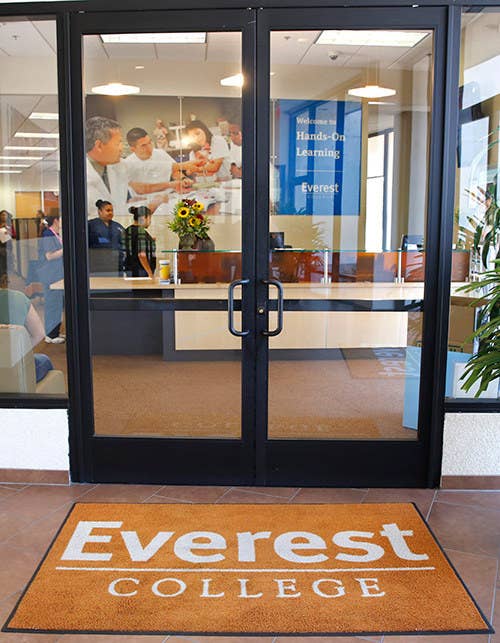
At every step of the way, people fell prey to Everest precisely because of tactics designed to capitalize on their poverty and their trust in an accredited university. Its advertisements targeted poor and minority students, capitalizing on their desperation for jobs to get them on the phone with admissions representatives. Those salespeople used classic high-pressure tactics to sign them up for programs that were up to five times the price of similar offerings at a community college, and twice as much as a state university. One former employee called the tactics she had been taught "beyond deceptive and immoral."
For many students, a major life decision that was meant to lift them out of poverty has left them more deeply entrenched in it.

If you want to see an advertisement for Everest, the best place to look is on daytime television. Airing during shows like Jerry Springer, Maury Povich, and The Price Is Right, Everest’s low-budget ads frequently feature young men and women talking candidly, and sometimes sharply, into the camera. In one, a young black man standing in a dark parking lot commands: “You’re sitting on the couch, watching TV, and your life’s passing you by … You spend all day on the phone anyhow, why don’t you make a phone call that’s gonna help you in your future?” He adds, shaking his head dismissively, “It’s easy.” Another features a woman standing on a freeway overpass.
The minute those who see Everest’s commercials make that phone call, they are met with a fine-tuned sales machine intended to get them to enroll as quickly as possible. Students spoke of receiving phone calls daily, even four or five times a day. The calls didn’t end until they agreed to speak at length with an admissions representative, by phone or on campus.
Everest’s admissions representatives are salespeople — the jobs are advertised as such by Corinthian, according to the California lawsuit. What they sell, though, is something much bigger than a college education, or even the promises of job placement services and $12 hourly salaries. They sell prospective students a future that many of them never imagined was possible.
Students told me they felt they had no choice but to enroll. Not to do so, they said, seemed like turning down a guarantee at a better life for themselves and their families. “They put on a great act saying how many jobs were available and how good I was gonna get paid,” Cacha Cherry, who graduated from Everest in 2010, wrote in an email about the first day she visited an Everest campus. “They told me about people who had gotten a job and had wonderful careers and great lives — how they were able to buy homes, go on vacations, and live this wonderful life.”
Cherry had no intention of enrolling that day, but the representatives prepared papers for her to sign, despite her protests. “I felt pressured to sign because I wanted to make a good living for my child — I was a young mother trying to make a better life for both of us.”
A former admissions representative at Everest, one of five with whom I communicated, said Everest taught a sales tactic her supervisors called “peeling the onion,” appealing to students’ emotions by asking them leading questions that focused on their hopes and dreams. “We’d say, ‘How do you think this degree will change your daughter’s life?’ or ‘How meaningful would being the first person in your family to graduate from college be?’ It was all about the emotional side.” She called the enrollment tactics she was taught “beyond deceptive and immoral, given the circumstances of the prospective students.”
Everest’s admissions representatives were under heavy pressure to sign up students — until recently, they were paid based in large part on how many students they enrolled, a practice that was made legal under a series of “safe harbor” laws passed by the Bush administration in 2002. Those rules were repealed by the Obama administration in 2011, but four former admissions representatives told me that their job performance was evaluated based in part on enrollment numbers.
“We had to hit certain enrollment numbers or risk our jobs,” said another former admissions representative, who asked not to be named because his current employer is also a for-profit college. “So plenty of students were enrolled that weren’t supposed to be.”
Jenkins denied this. Company-wide evaluation standards, the company spokesperson said, “do not include the number of students [admissions representatives] enroll.”
Former students said Everest’s admissions office also used tactics more akin to those found in high-pressure sales environments. Many students who visited Everest’s campus for tours or simply to pick up brochures said they found themselves ushered into the enrollment and financial aid offices, bombarded by promises about job placement and encouraged to make a choice to better their futures. To get them to enroll immediately, Everest representatives often told students that they risked losing their spot in the school or that the semester was about to begin without them, suggesting they may have to wait months or even a year before the next chance to enroll.
“It was considered a failure if we didn’t enroll by the end of the day” of their first visit, said the former admissions representative. Two other former admissions officers made similar assertions. If students seemed hesitant to enroll on their first visit, one representative said, administrators "would meet with them personally" before they left campus.
Students said that as a result of the rushed, single-day process, they were given little time to read the documents they were signing. They instead trusted the word of the admissions representative who explained the documents.
“I remember feeling extremely overwhelmed and confused about what was happening, and by the end of the conversation, I’d basically signed up for the school and was beginning classes,” said LaShayna Bell, of Tempe, Arizona, who enrolled in 2010. “It was like I blinked and missed what I’d done.”
Jenkins said that it is “extremely rare” for a student to enroll on the first visit, but would not specify whether that included signing preliminary paperwork. “We encourage students to take their time and consider it carefully,” Jenkins said. “We encourage prospective students to bring a family member or close friend on the first visit, and to ask questions about all aspects of the program.”
That family member, however, sometimes turned into another opportunity for the company. Interviews with admissions representatives and former students show that Everest’s tactics were so aggressive that the school sometimes also enrolled the mothers, sisters, and spouses who accompanied prospective students on campus visits.
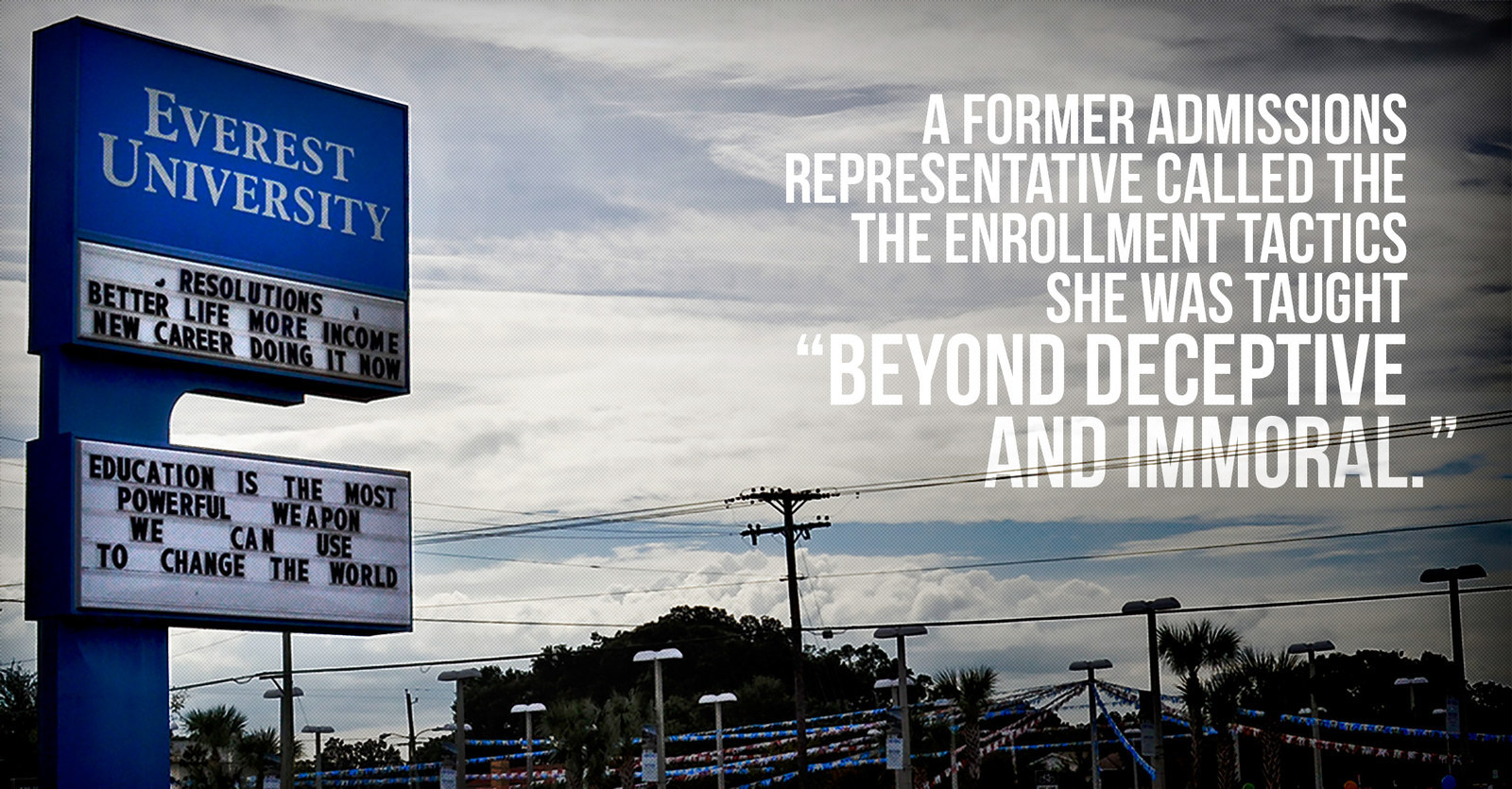
The vast majority of Everest’s students have no prior experience with college — few relatives who attended themselves or high school counselors to help navigate the process. Sintia Lopez, a veteran, emigrated from Nicaragua when she was 12, unable to speak a word of English; she knew nobody who had ever gone to college. She believed her Everest representative when she was told that the school was one of the best in Florida, and believed the representative’s claim that the high tuition was a sign of quality education that she wouldn’t get at a community college. She didn’t know that it was abnormal for a school to call you at all hours of the day, begging you to enroll.
Admissions representatives enrolled many students who were unlikely, or even unable, to succeed in college: Among those I spoke with, more than a dozen did not have a GED, including an eighth-grade dropout who was enrolled in an accounting program. Several were violent felons who could not legally be employed in the health care industry or criminal justice jobs offered by their programs.
Many more appeared to be only semi-literate and were unprepared to handle college-level work. One student, who had completed a medical assistant program months after being released from jail on a felony assault charge, wrote to me: “I need getting loans with cleared cause I had just got out of prison and I dont a ged and they promised they would get me a job my name [redacted] please help me.” She asked not to be named because of her felony.
At Everest’s Milwaukee outpost, according to allegations in the Wisconsin attorney general’s lawsuit, the campus president insisted on turning away students with criminal records who wanted to enroll in health care programs because they could not be employed in the fields they were training for. When the president left, the suit alleges, the school not only ceased using background checks, it called back those students with criminal records who had been turned away and tried to enroll them.
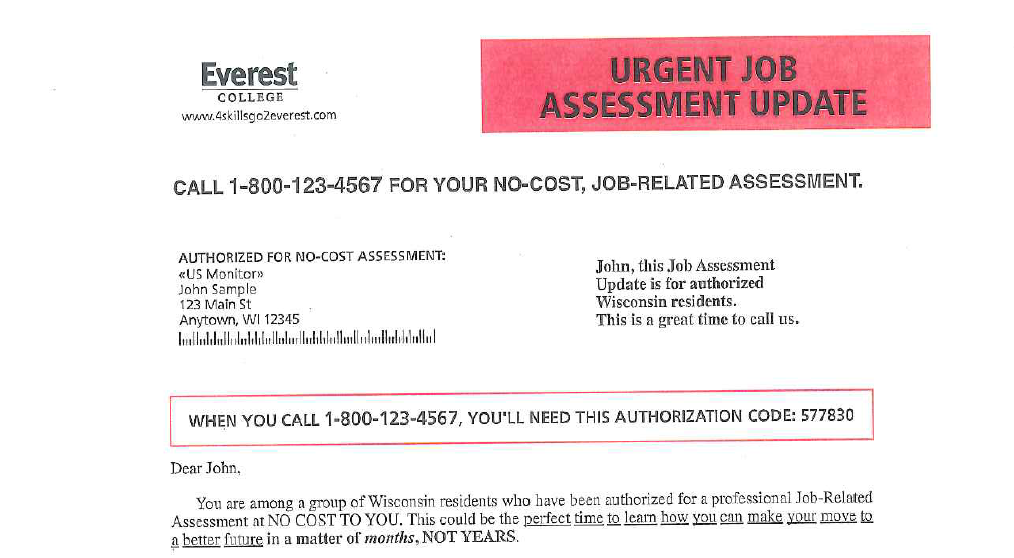
Everest voluntarily closed the Wisconsin campus two years after its opening, acknowledging it had problems. At the urging of regulators, the company agreed to issue refunds to students who had not graduated. (Those with diplomas, regardless of whether they'd found employment, received no money.) Jenkins said the fact that the company had ultimately shut down the Wisconsin campus was evidence that Corinthian was committed to addressing wrongdoing.
“It is not in our interest to enroll students who can not successfully complete their courses, and we have policies that are based on that understanding," Jenkins said.
In 2009, according to regulatory filings, 23% of Corinthian students did not have high school diplomas or GEDs. The company stopped enrolling students without diplomas in 2010, after the government no longer allowed them to receive federal financial aid.
The first former admissions representative spoke of enrolling many students who had such limited English proficiency that she believed them unable to complete their courses, such as a mother and daughter she enrolled in a massage therapy course — which requires learning anatomy and physiology — who “could not carry on a basic conversation” in English. Her boss, the admissions representative said, told her to “put them through anyway” and ensure they sat in the class for at least five days, enough time for the school to collect their government funding. The mother and daughter did not make it through the semester.
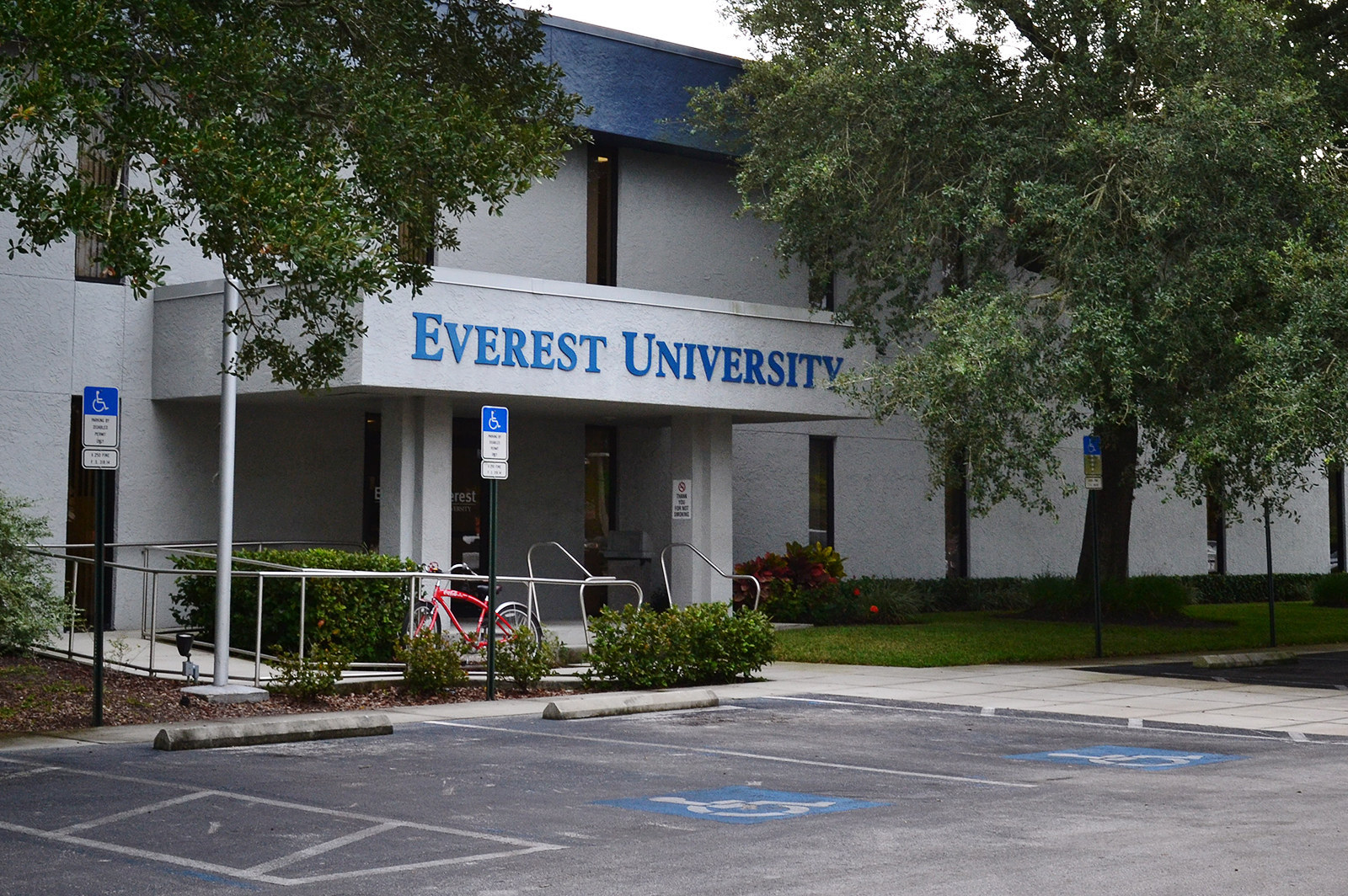
Five months ago, Lisa Roberts enrolled at the Everest University campus a few blocks away from her Lakeland, Florida, home for one reason: She needed a job, desperately. Everest told her she was very likely to get one paying $14 an hour in her field of study, medical assisting — a nine-month certificate degree program for which she would pay $16,400. “It’s money I can’t really afford,” Roberts told me. “But I feel like this is the only thing I got.”
Roberts, her husband, and their three elementary school–aged children live on the $8-an-hour salary her husband makes as a laborer in a nearby salvage yard, renting a small, sparsely furnished home from her husband’s boss. (Her name was changed because she is a current student.) Roberts' son, who is on the autism spectrum, is homeschooled because of his frequent and sometimes violent outbursts, and she is counting on a night job at a hospital so she can stay home with him. Her 11-year-old niece moved in with the family in September.
If she doesn’t get a job, Roberts said, “I honestly don’t know what I’ll do. We’re counting on this for a lot of reasons. We’re completely counting on it.”
But Roberts is already worried. In her last two months at Everest, she has had seven teachers for a single medical assistant course. She tallies them off on her fingers: Most quit, one saying she’d never been paid, several moved, others disappeared with no explanation. “We show up and they’re gone,” she said. Instead of normal good-byes at the end of class, she said, students say to teachers, “Hope we see you tomorrow!”
Allegations in the many lawsuits against Corinthian Colleges paint a grim picture of the likelihood that Roberts will get the medical assistant job she says she was promised.
To encourage students to enroll, Corinthian routinely told prospective students that they had job placement rates of 70%, often as high as 90%. But those were “substantially and materially false,” according to allegations in the Massachusetts lawsuit: In one example, a 72% placement rate was in fact 23%.
In its lawsuit, the California attorney general's office alleges that just a tiny fraction of the jobs Everest claimed it had placed students in, often around 30%, could be fully verified. Most job placement records were “missing,” and for those records that could be found, the company routinely counted short-term positions as “careers” or included jobs that students were working outside of the fields they had trained for. One example cited in the suit were dozens of students whose “careers” consisted of placements at health-screening fairs that lasted just two days.
“In some cases,” the California suit reads, “there is no evidence that a single student in a program obtained a job during the time frame specified.”
Allegations about falsified and misleading job placement rates are also at the center of the federal lawsuit, as well as suits in Wisconsin and Massachusetts and investigations in six other states. The lawsuit in Wisconsin alleges that in 2011, the actual job placement rate at Everest’s Milwaukee campus, which the company voluntarily shut down in 2012, was 5.5%.
Corinthian strongly disputes these allegations, saying that the “vast majority” of Everest’s graduates find a job in their field. The company argues that the standards used to verify jobs in the Massachusetts suit, requiring job placements to be long-term, are not reflected in state law. In the California suit, Corinthian said, the state selectively pulled from emails and internal documents to create “out-of-context” and “misleading” impressions of the company’s job placement rates.
“We have a vested interest in helping our graduates succeed in the job market,” said Jenkins. He added that Everest’s accreditation is tied to its ability to prove that its students are placed in jobs: It must submit job placement statistics and records to the school’s accrediting body.
The lawsuits against the company allege that those numbers, too, were falsified.
Students told me that Everest’s advertised job placement programs were limited to things like reviewing resumes and, in many cases, were all but nonexistent. Several students said that Everest staff had simply forwarded them Craigslist postings or referred them to classified ads in local newspapers. Many said they had been placed in temporary jobs, called “externships,” which were pre-arranged with employers and lasted anywhere from a few days to months. But once they graduated and the temporary internships the school had placed them in were over, students said, they were unable to get back in touch with job placement staff.
For Mary Parks, who graduated from Everest in January, Everest’s “job placement services” were limited to a single emailed job opportunity, a non-management internship at the retailer where she was already a cashier. After she told the school that she didn’t get the job, “I have not seen or heard from them since,” she said, despite emails to her caseworker. Parks has an associate degree in business management that cost $34,000, but is working a part-time job that pays just above minimum wage.
Corinthian said it employs 600 career counselors for its 70,000 students, and that an internal corporate verification team checks the company’s job placement claims. “We know of no traditional college or university that has made a remotely comparable commitment to career services,” said Jenkins. Community colleges generally have much lower graduation rates and lower employment rates, and employ just a handful of career counselors per 1,000 students.
Jenkins said that the company “does not promise employment to students, period,” and does not directly provide students with information about salaries, instead referring them to the Bureau of Labor Statistics.
Somehow, however, more than 50 students who contacted me came away from Everest with the impression that they had been “promised” jobs that they did not receive. Allegations in the Massachusetts lawsuit against Corinthian back up the students’ assertions: The suit alleges “Corinthian employees promised or guaranteed employment despite knowing it could not fulfill such promises.”
The Association of Private Sector Colleges and Universities, the country’s biggest for-profit college lobbying group, argues that even if they fail to immediately find well-paying jobs after graduation, students leave Everest and other for-profit schools better off than when they entered: At least they have a degree or certification, and thus a chance at a better job.
But an overwhelming majority of the students that I spoke to believe the opposite: They said, often fiercely, that they wished they had never enrolled.
“It was the worst decision of my life,” said Christine Gillan, who is $12,000 in debt for a medical assistant certificate she received in 2009. She never found a job in her field and now works as a cleaner at a health club.
“It’s so sad that I worked so hard and have nothing to show for it,” said Tiffany Jones, a mother of four who graduated from an Everest program in medical billing in Reseda, California, last year, but never found a job in her field. Jenkins, the Corinthian spokesman, said the school had made several efforts to reach out to Jones, which she did not respond to, and had ultimately helped her set up a job interview. Her experience, he said, “demonstrates that employers value an Everest education and were willing to interview her.”
At that interview, Jones said, the employer asked her why she had wasted her money on an Everest education instead of a different, cheaper school. She didn’t get the job.
“I have nothing to show my children about why staying in school is so important,” one former student said. “I feel so taken advantage of.”
“I have nothing to show my children about why staying in school is so important,” Jones said. “My husband and I are still struggling to keep food on the table, a roof over our heads, and our bills paid. I feel so taken advantage of.”
For those who cannot get a job through Everest’s placement programs, its degrees have almost no value in the educational world. Everest consistently tells students it is a “nationally accredited school,” and many students assume that means their credits are transferable; some students said they were specifically told that their credits would transfer. But while Everest is nationally accredited, almost all nonprofit schools have regional accreditations, and accept few, if any, Everest credits. Transferring in most parts of the country is all but impossible.
Jenkins said students must initial a paragraph in an enrollment document stating that transferability is out of Everest’s control and that students “should expect credits not to transfer.” He noted that national accreditation, which is designed specifically for career programs, has more stringent standards than regional accreditation, such as job placement and graduation requirements that community colleges do not have to meet.
He also pointed to a single state, Florida, where thanks to a statewide course record system, a selection of Everest’s courses are transferable to public universities.
The lack of credit transferability works in Everest’s favor, interviews with former students show. Students who become dissatisfied with the school partway through their education, or who realize months into their program how expensive the degree will be, have no choice but to stay, unable to take their credits to community colleges or public schools.
And if they want to further their education by getting a more advanced degree, such as an associate or bachelor’s, students said they had no choice but to return to Everest, even if they were dissatisfied with their original programs.
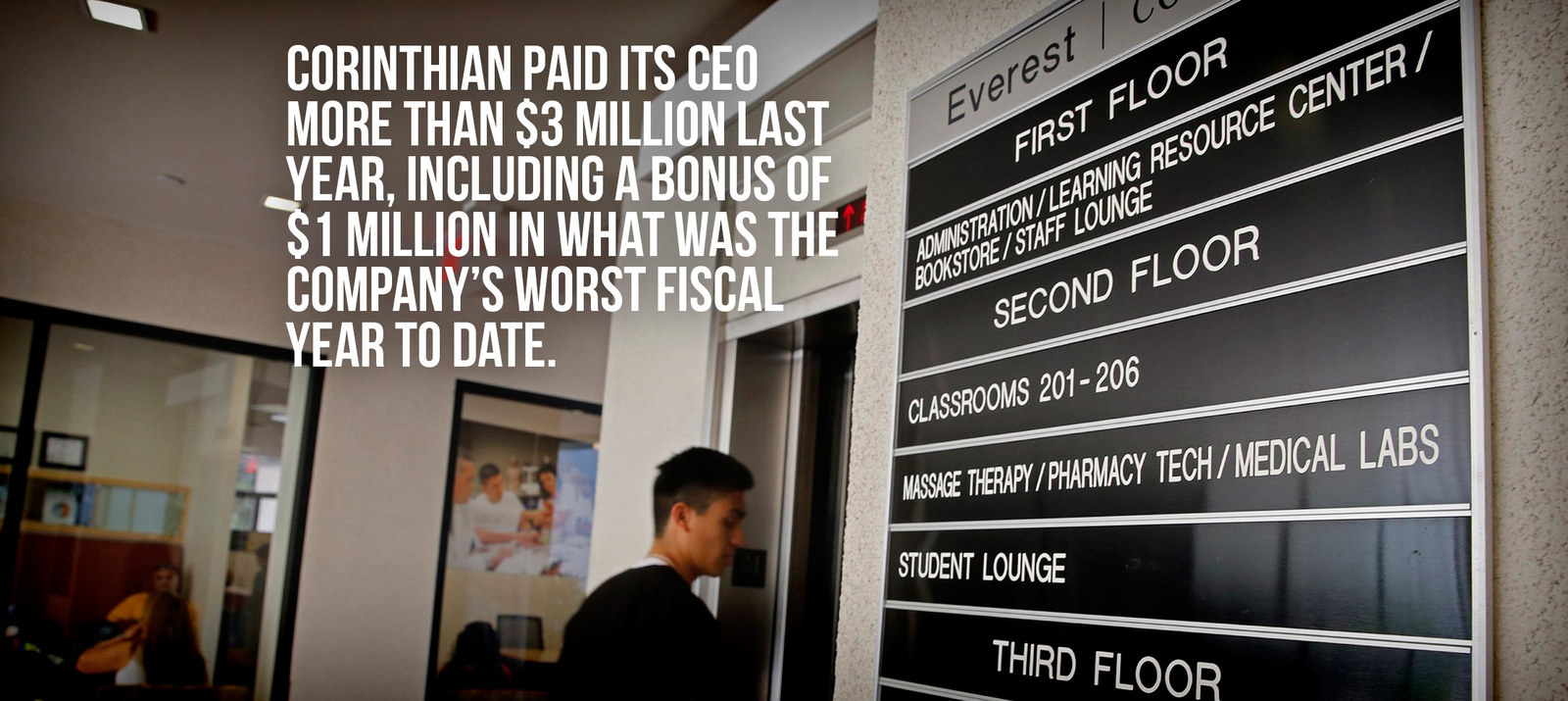
Corinthian paid its CEO, Jack Massimino, more than $3 million in compensation last year, including a bonus of $1 million in what was the company’s worst fiscal year to date, according to SEC filings. Massimino has served as CEO since 2004. His 10,000-square-foot mansion in Park City, Utah, built in 2007, was recently listed for $11.5 million. With vaulted ceilings and two-story windows overlooking the mountains on either side, the mile-wide property includes its own pond at the foot of the mountains, a heated equestrian barn and caretaker’s apartment, and an “art barn” for children.

In 2010, Massimino’s wife was featured in a Utah news story after a custodian found her $25,000 diamond ring in an airport. The ring, the story said, had been a gift for the couple's 25th anniversary.
Massimino has rarely given interviews and has stayed silent since the shutdown was announced, deferring comment to the school’s spokesperson.

Corinthian’s board of directors, which oversees the business, has been home to a number of prominent social and political leaders. Marc Morial, the president of the National Urban League, the nation’s largest civil rights organization, is still a director; he joined soon after the company donated $1 million to his organization in 2012. Morial is paid upwards of $60,000 a year for his service on the board. A prominent Democrat, he was the mayor of New Orleans for eight years and once sat on President Obama’s Equity and Excellence in Education Commission, which was tasked with addressing opportunities for the federal government to address educational inequality.
In a statement to BuzzFeed News, Morial said, “I joined the Corinthian board as someone who is committed to civil rights and equal opportunity for all and who has spent a lifetime working to advance that mission... As many institutions have increasingly shifted from extensive offerings of career and vocational training, a void has emerged across the country for students, especially non-traditional students, to have an opportunity to learn a trade and gain desirable workplace skills. The concept of increased vocational training to help fill this void is sound, and it absolutely must be delivered positively, ethically and within the law.”
Another Corinthian director was Leon Panetta, the former secretary of defense, who sat on the board during the years of the school’s biggest growth, from 2008–2009. He left to join the Obama administration, then rejoined the board in 2013, a year after a Senate report on for-profit colleges found Corinthian to be among the worst performers in the industry, with student loan default rates higher than any other publicly traded company. He left the board after just 11 weeks, facing pressure from critics of Corinthian. Panetta declined to comment for this article.
While the directors oversaw the business and were paid for their time, its owners were the biggest beneficiaries of its profits. One of the company’s largest shareholders has been Graham Holdings, formerly the Washington Post Company, which also owns Kaplan Inc., an education company and for-profit college chain.
And throughout its troubled final years, Corinthian was supported by industry lobbyists, most notably the Association of Private Sector Colleges and Universities, or APSCU. APSCU has been a force in Washington politics, most notably suing the Obama administration after a 2011 attempt to regulate the for-profit college industry, forcing the administration to revise the rules, delaying implementation for three years. Corinthian, an APSCU member, would have been among the hardest hit by those rules.
But ultimately, taxpayers were the company’s largest supporter. Corinthian received 83% of its revenue from tax dollars at its enrollment peak in 2010, some $1.4 billion, and has raked in about $10 billion in the past 10 years. And it is taxpayers, through the federal student loan system, who will effectively act as debt collectors, chasing Everest’s former students for payment for the rest of their lives.

In 2007, the California attorney general filed a lawsuit against Corinthian Colleges, Everest’s parent company. California’s complaint against Everest and Corinthian included a litany of allegations: falsified job placement statistics, aggressive and unethical sales practices, and a pattern of jobless graduates carrying mountains of debt.
But that case never went to trial: The lawsuit was immediately settled with no admission of wrongdoing on Corinthian’s part. The company paid a $500,000 civil penalty and $4.3 million in restitution to students at campuses that had notched the worst violations. As of this year, according to a source familiar with the matter who spoke on background, $3.4 million of that money has been paid out to 6,000 eligible students, for a total of approximately $560 each.
Six years later, a new California attorney general, Kamala D. Harris, filed a new lawsuit against Corinthian that was, for the most part, indistinguishable from the first complaint, detailing the same violations, alleging that the company had materially broken every agreement made in the previous settlement. The recent federal lawsuit, and those in Massachusetts and Wisconsin, trace similar lines.
The Department of Education began its own investigation into Corinthian in January, requesting details on everything from the company’s job placement rates to financial aid practices. In June, it claimed Corinthian was taking too long to respond completely, and temporarily cut off the school’s access to the federal financial aid money that made up almost 90% of its revenue. Corinthian was so short on cash that even the 21-day delay sent them into a financial tailspin, threatening bankruptcy; the DOE eventually agreed to release the funds, but only on the condition that Corinthian would sell off or close all of its campuses within six months. The final list included only 12 schools that would be shut down; Corinthian plans to sell the other 85, likely to a private equity firm or a for-profit competitor.
But the lawsuits, investigations, and even the Department of Education’s forced shutdown are unlikely to result in any real change for the vast majority of Everest’s current and former students. One of the deep ironies of Corinthian’s collapse is that there are, experts say, effectively too many victims for there to be any reasonable way to compensate them, or to actually shut down the dozens of Everest campuses. It would cost the government billions to forgive the outstanding debt of former students, and any attempt to shut down Corinthian’s schools would displace 70,000 current ones.
The lawsuit by the Consumer Financial Protection Bureau seeks debt relief for students — but only on a tiny fraction of loans, those made directly by Corinthian, not the federal loans that make up the vast majority of students’ debt. Lawsuits in California, Wisconsin, and Massachusetts may provide some restitution to former students in those states, but like the 2007 settlement, would do little more than chip away at students’ loan tallies.
Corinthian College’s impending demise will likely work against former students, said Pauline Abernathy, the vice president of policy organization The Institute for College Access and Success. “The issue is, if [the government] were to win a lawsuit, where would the money come from to compensate students?” Abernathy said.
It’s all but impossible that any real money will come from Corinthian. Corinthian is so cash-strapped that it has been selling off assets — even equipment belonging to its chain of automotive schools — just to stay afloat until it finds a buyer for its campuses. It is extremely unlikely, experts agree, that any state would be able to recover a substantial settlement from the company.
“The chances are slim” that former students will ever see any kind of meaningful debt relief, said Maura Dundon, senior policy counsel at the advocacy group Center for Responsible Lending.
And because all former students signed arbitration agreements, Dundon said, they are unable to take part in class-action lawsuits in open court, and must instead take their cases to arbitration. That can be problematic because arbitration suits are difficult to file, and, in a more business-friendly environment, do not carry with them the right to appeal. “The worst thing is that the process is not public, so you can’t find out what the allegations are,” said Dundon.
In the years between when the two lawsuits were filed in California, Everest boomed, reaching a height of 113,000 students in 2010. That was the year immediately after the economic crisis, when students flocked to for-profit schools in search of jobs. Enrollments — and revenues — fell sharply beginning in 2010, and Corinthian’s stock price slid alongside it. In 2009, the company was valued at around $1.4 billion. In the wake of the Education Department’s shutdown, its shares have been trading at around 18 cents, valuing the business at $14 million — just $2.5 million more than the asking price of Massimino’s house.
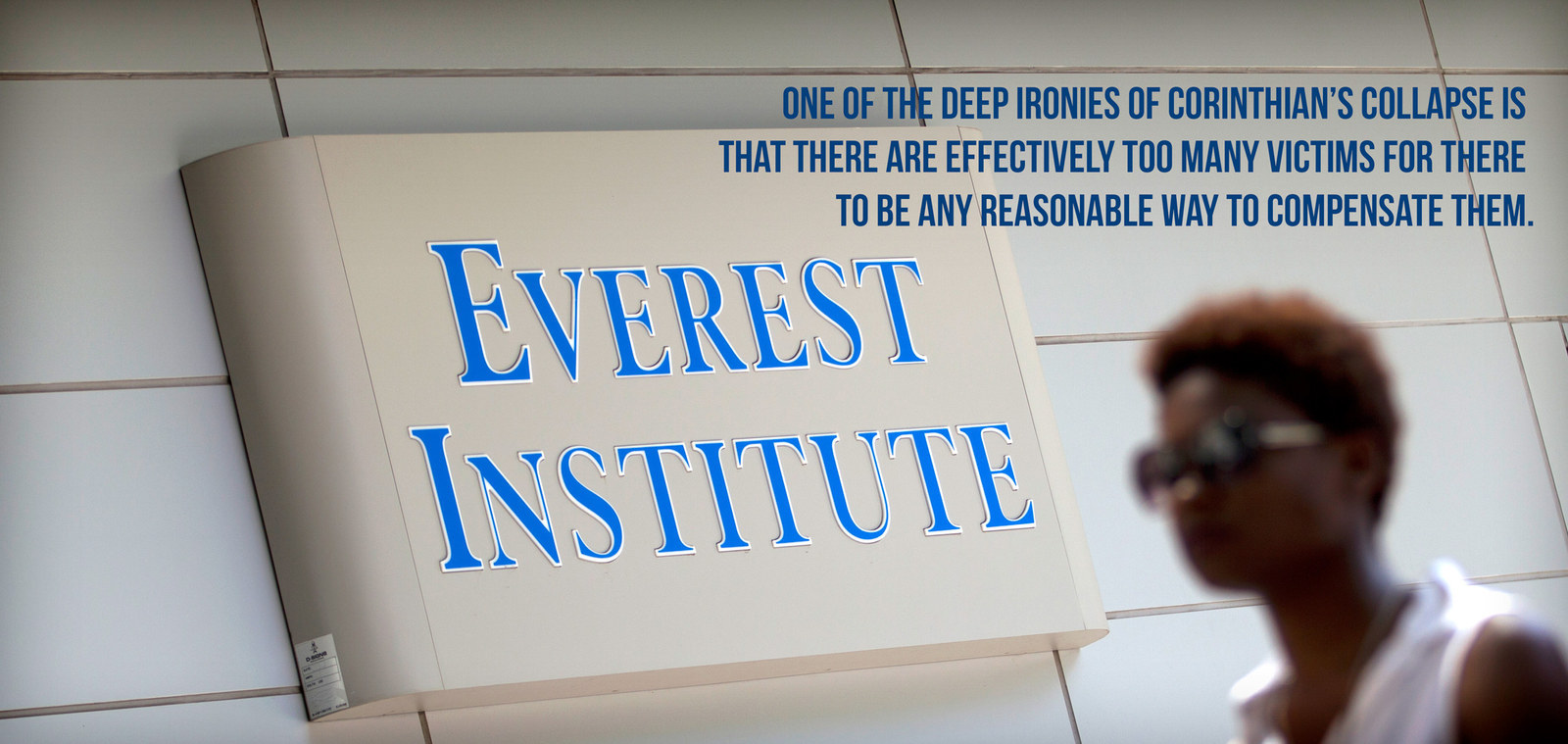
Many Everest students who contacted me had deep misconceptions about the most basic financial aspects of their expensive educations, from the amount of tuition to who was shouldering the cost of their degree. Kelli McClendon, a former student of Everest College Online, wrote: “I was getting $5500 financial aid. The course was only $4500. Yet I found out I still had to take out loans to pay for my classes.” The cost of McClendon’s program was actually $13,500 — she had been told the cost for one quarter, rather than three.
The students who told me that they were misled about the nature of their debts had all ostensibly gone through financial aid counseling, signing papers that listed the amount of money they were borrowing and the interest rates on their loans. That’s a government-mandated process, designed to ensure students understand the implications of the debt they are about to enter into.
But interviews with former students and employees show Everest’s version of that process obscured the full cost of its education and sometimes even led students to believe that they were not borrowing money at all. Some said their loans were misrepresented as grants that would not have to be repaid. Students said they were given a “tuition cost” that was per quarter or per credit, apparently without explaining that distinction. Others were told they would “pay nothing out of pocket,” or that the school would help them find “government-sector jobs” where they would not have to repay their loans.
Failing to provide complete program costs to students is in violation of Corinthian’s policies, said Jenkins. “Any suggestion that clear information about the cost of programs is not made available to prospective students is demonstrably false,” he said. He pointed to Corinthian’s website, where, he said, “You can see that anyone can visit one of our websites and get the precise cost of any program and the availability of grants and loans to cover that cost.” (This is the type of page most students would navigate to find out program costs.)
Admissions personnel were never allowed to discuss financial aid directly with students, according to the first former admissions representative — “they would fire you on the spot if you mentioned financial aid” — but were instead told to promise students that, once they had signed initial enrollment papers, they would be given financial aid counseling. But more often than not, she said, students left that single counseling session confused about what they had signed. “A couple days into class, I’d often get calls from students I enrolled saying, ‘I think I took out a loan? I don’t understand, what did this mean?’” she said. “But you couldn’t answer. You could only give them the runaround and say, ‘Don’t worry, you won’t have to pay it back until after you graduate.’”
Often, the admissions representative said, and especially with students who spoke limited English, “I got the impression they didn’t know what they were signing.”
Though they were presented with papers that would have explained the terms and amounts of the grants and loans they were taking out, many students said they were not given time to read the papers. They instead trusted the words of their financial aid counselors, who promised to “explain everything.”
One former financial aid counselor at Everest College-Phoenix said she and other representatives “never discussed anything about the total cost of attendance” with students. When total costs came up, students were quickly assured they would be “covered by financial aid.” By the end of a single phone call with online students, the financial aid counselor said, she had signed students up for tens of thousands of dollars in loans, often without the student’s full understanding of what they had agreed to.
Everest educations are expensive: More than five times as expensive as a degree from a community college, and twice as expensive as a degree from a state university. The cost is no accident; it’s largely a by-product of a federal rule governing for-profit colleges, known as “the 90/10 rule,” which mandates that schools can draw a maximum of 90% of their revenue from federal aid money.
Everest’s tuition is set at a price high enough that some students eventually max out their federal aid, forcing them to turn to other sources to pay for the final slice of their tuition, often around $5,000. Usually, that “funding gap” is covered by a private loan made by Everest itself, called a Genesis loan, which charges a maximum of 9.9% interest, nearly twice as much as an unsubsidized loan made by the federal government.
Dozens of students said that they were not informed ahead of time that they would need to take out private loans in addition to government funding. Most said they were told within months or even weeks of graduation that they had "run out of funding, and that if they wanted to graduate, they would need to sign up for a Genesis loan."
Jenkins noted that less than 40% of Corinthian’s students take out private loans. “This program was never intended to be and has never been a profit center,” he said.

Paula Dougherty isn’t sure how much money she’s paying for a two-year associate degree in business administration at Everest University Online; she was never told, and she never asked. When Dougherty thinks about money, she thinks in smaller sums. Five dollars' worth of gas for her cousin’s truck to get from her home in rural Alabama to her doctor’s appointments. Money for groceries when her family’s food stamps run out.
Dougherty is unemployed and living on $700 a month in disability payments; she has only ever had one job, as a greeter at Walmart, which lasted two months. Four hundred dollars are eaten up in rent for a bedroom in a mobile home on the outskirts of Warrior, Alabama, which she shares with her aunt, uncle, cousin, his wife, and a dozen dogs and cats.
So the stipend checks Dougherty gets from Everest every semester — essentially cash payments taken from student loans — are more than a bonus. The payments, sometimes up to $900, have become a necessity. “I need them for gas and rent,” she said. “If we’re low on food and run out of stamps, we go hungry for a while. If I have one of those checks, I can go out and buy food.”
What Everest calls “stipend checks” are refunds of federal loan dollars — what is left over from the money students borrow for their educations. The government allows borrowing up to a maximum amount, which includes the costs of housing and supplies. Many low-income students, like Dougherty, said they are reliant on these sums to cover basic costs; several said the money was the primary reason they remained enrolled.
Depending on who you ask, the fact that for-profit colleges disproportionately enroll poor and minority students is either a troubling example of exploitation — or of an industry stepping up to serve students who might otherwise have no access to a degree.
Depending on whom you ask, the fact that for-profit colleges disproportionately enroll poor and minority students is either a troubling example of exploitation — or of an industry stepping up to serve students who might otherwise have no access to a college degree. For-profit colleges say they offer poor and working students things that public and nonprofit colleges cannot: job-centric degrees, flexible course schedules for single parents and full-time workers, environments geared toward older students and veterans rather than recent high school graduates.
The numbers behind the industry as a whole are troubling: Just 13% of American higher-education students attend for-profit colleges, but they account for 30% of all outstanding student loans — and almost half of student loan defaults. The graduation rate stands at 32%. But the for-profit college industry defends those figures by saying they are explained by the schools’ demographics: Studies have shown poor students are less likely to graduate, and it stands to reason that they have to borrow much more too. They also frequently compare themselves to community colleges, where graduation rates are actually lower and loan default rates often equally as high.
Community colleges are significantly less expensive: an average of $8,500 vs. $35,000, meaning that only 42% of community college students are forced to go into debt for two-year degrees, compared with more than 88% of for-profit college students. They borrow, on average, twice as much as community college students.
The for-profit college industry has also come under fire for much more than its student borrowing and graduation rates. Corinthian is widely known as being among the worst offenders in the industry, but it’s far from alone in its record of legal action. In January, attorneys general in 12 states announced investigations into the practices of three massive publicly traded for-profits: EDMC, ITT Educational Services, and Career Education Corporation. EDMC, which recently delisted itself from the stock exchange, faced a similar investigation in 2010; the 55,000-student ITT Educational is being investigated by the SEC and sued, like Corinthian, by the Consumer Financial Protection Bureau.
The University of Phoenix, the country’s largest and best-known for-profit, has been investigated in several different states. It settled with the Justice Department over its recruiting practices for $67 million in 2009, after a government review, according to the Arizona Republic, “paint[ed] a picture of a school so hungry to enroll new students that it has threatened and intimidated its recruitment staff in meetings and e-mail, pressured them to enroll unqualified students and covered up its practices to deceive regulators.”
For its part, the Obama administration has tried — and, so far, failed — to impose meaningful regulations on the industry. In 2011, the administration rolled out a series of so-called “gainful-employment” regulations meant to shut down the worst-performing career college programs. Programs were required to meet one of two metrics relating to loan repayment and debt-to-income ratios. Those that failed were disproportionately for-profit college programs.
Many critics of the industry actually regarded the 2011 regulations as too lax, criticizing the administration for bowing to the demands of for-profit college lobbyists. The most prominent for-profit lobby group sued the Education Department anyway, and the rules were thrown out on a technical argument that the metrics chosen by the department were arbitrary.
Last week, the administration released a new version of the regulations that, though tougher than the 2011 iteration, caved in to a key lobbying demand by the for-profit college industry. Some lawmakers are skeptical the new regulations will work as hoped. “I do not believe that this rule will be enough to prevent bad actors in the for-profit sector from gaming the system and taking advantage of our students,” said Rep. Mark Takano, a California Democrat, in a statement. APSCU, the for-profit college lobbying organization, has already filed a lawsuit to strike down the new attempt at regulation.

Jennifer Wilson still keeps a framed portrait in her living room of herself at graduation, beaming in a cap and gown and holding a leather folder that reads “Everest University” against her chest. She was so happy in that moment, she said: She had finally graduated from college — a dream she’d had since she was a teenager — with an associate of science degree in criminal justice. She was on her way, she hoped, to a better job.
But Wilson, who lives in Cape Coral, Florida, was yet to understand the extent of the debt she was carrying. “I had no idea how much my loans were coming to,” she said; she had been rushed through the signing process without anybody mentioning the total cost of her program. Weeks after graduation, she started getting bills for the rest of her student loan debt. The total cost of her two-year associate degree: $40,000.
She would soon find her degree was essentially "worthless," she said, and came with none of the job placement services she’d been promised. No police departments would hire her, although she’d been told her program had a near-perfect job placement rate; it was 2010, so some blamed the economy, but others said it was because of the quality of her degree.
At her local community college, Wilson learned, a similar two-year degree would have cost around $7,000.
By then, the joy of that Everest cap-and-gown moment was long gone. It had begun to fade even on graduation day. As she walked off the stage that afternoon, she opened the embossed folder for a first look at her diploma; instead, she found a letter from Everest, demanding that she pay $3,000 in private loans she still owed the school. Until she paid up, she wouldn’t officially graduate or receive her diploma. With a salary of $25,000 a year, it would take her three years, and a loan from her mother, to come up with the money.
“I hated myself,” Wilson said, her voice catching as she spoke. She is still working in the same job she had when she graduated. “I thought, I am so much smarter than this. I still can’t believe I fell for it.”

